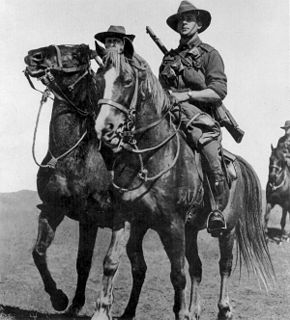
Australian Light Horse were mounted troops with characteristics of both cavalry and mounted infantry, who served in the Second Boer War and World War I. During the inter-war years, a number of regiments were raised as part of Australia's part-time military force. These units were gradually mechanised either before or during World War II, although only a small number undertook operational service during the war. A number of Australian light horse units are still in existence today.

The Royal Australian Armoured Corps (RAAC) is a corps of the Australian Army which provides the Australian Defence Force's armour capability. Armour combines firepower, mobility, protection and networked situational awareness to generate shock action and overmatch in close combat. Armour is an essential element of the combined arms approach that is employed by the Australian Army.

1st Armoured Regiment is an armoured regiment of the Australian Army and is the senior regiment of the Royal Australian Armoured Corps. Formed as a tank unit in the new Australian Regular Army on 7 July 1949, the regiment subsequently saw service during the Vietnam War operating Centurion tanks. Currently the unit is based in Edinburgh, South Australia as part of the 1st Brigade. As part of the Plan Beersheba reorganisation, the unit has become one of three Armoured Cavalry Regiments (ACRs) assigned to the Army's multirole combat brigades in Brisbane, Darwin and Townsville. Each ACR is equipped with M1A1 tanks and ASLAV light armoured vehicles.
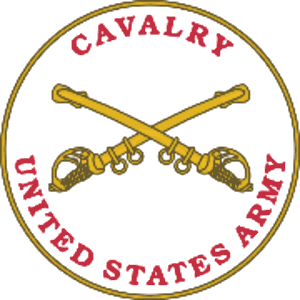
The United States Cavalry, or U.S. Cavalry, was the designation of the mounted force of the United States Army by an act of Congress on 3 August 1861. This act converted the U.S. Army's two regiments of dragoons, one regiment of mounted riflemen, and two regiments of cavalry into one branch of service. The cavalry branch transitioned to the Armored Forces with tanks in 1940, but the term "cavalry", e.g. "armored cavalry", remains in use in the U.S. Army for mounted reconnaissance, surveillance, and target acquisition (RSTA) units based on their parent Combat Arms Regimental System (CARS) regiment. Cavalry is also used in the name of the 1st Cavalry Division for heraldic/lineage/historical purposes. Some combined arms battalions are designated as armor formations, while others are designated as infantry organizations. These "branch" designations are again, heraldic/lineage/historical titles derived from the CARS regiments to which the battalions are assigned.

The Waikato Mounted Rifles (WMR) is the New Zealand Army's only Territorial Force squadron of the Royal New Zealand Armoured Corps (RNZAC). The Squadron's origins can be traced back to 1869 when the first mounted unit was raised in the Waikato. Today the Squadron is part of Queen Alexandra's Mounted Rifles (QAMR) where it forms the regiment's reserve squadron. WMR's role is mounted reconnaissance and surveillance.
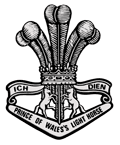
The 4th/19th Prince of Wales's Light Horse is a cavalry regiment of the Australian Army. The regiment in its current composition was formed in 1948 when the Citizens Military Force (CMF) was re-raised after the completion of the demobilisation process following the end of the Second World War and it was formed through the amalgamation of three previously existing regiments. Through these predecessor units, 4/19 PWLH can trace its lineage back to the 19th century and today it is the custodian of the battle honours earned by these units. The regiment had a Regular squadron, 1 Troop 4th/19th Prince of Wales Light Horse Regiment, which was posted to South Vietnam in 1965 where it was attached to 1 RAR operating out of Bien Hoa Province. It returned to Australia on 28 May 1966 and became part of the Regular cavalry units that continue to exist in the Australian Army today. These units subsequently served during the Vietnam War and many of their personnel continued to wear regimental accoutrements while in South Vietnam.
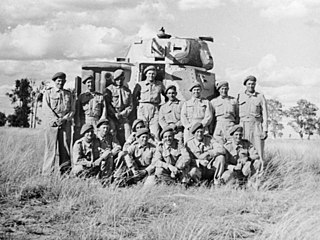
Armoured units made a relatively small, but important, contribution to Australia’s war effort during World War II. While Australia formed three armoured divisions and two independent armoured brigades during the war, Australian armoured units only saw action as independent regiments and companies supporting larger infantry formations. Early actions were fought in the Middle East by the divisional carrier regiments that supported the 6th, 7th and 9th Divisions, fighting in Libya, Egypt and Syria in 1941–42, before the Australian divisions returned to Australia in 1942–43. During the early fighting in the Pacific, there was a limited role for armoured formations, although one armoured regiment – the 2/6th – took part in the fighting around Buna–Gona in late 1942. Later in the war, though, during the Huon Peninsula, Bougainville and Borneo campaigns of 1943–45, several armoured units were used by Australian forces in the infantry support role.

The Pentropic organisation was a military organisation used by the Australian Army between 1960 and 1965. It was based on the United States Army's pentomic organisation and involved reorganising most of the Army's combat units into units based on five elements, rather than the previous three or four sub-elements. The organisation proved unsuccessful, and the Army reverted to its previous unit structures in early 1965.

The 12th/16th Hunter River Lancers is an Australian Army Reserve cavalry regiment. It was formed on 1 May 1948, although it draws its lineage from units that were originally formed in the 1880s. It is currently a Light Cavalry unit equipped with Bushmaster Protected Mobility Vehicles. The regiment forms part of the 11th Brigade, attached to the 2nd Division and draws its members from regional centres in northern New South Wales, hence the reference to the Hunter River. Since 2000 the regiment has provided individuals as reinforcements to round-out Regular Army units deploying overseas on peacekeeping operations and in the conflicts in Iraq and Afghanistan.

Armoured reconnaissance is the combination of terrestrial reconnaissance with armoured warfare by soldiers using tanks and wheeled or tracked armoured reconnaissance vehicles. While the mission of reconnaissance is to gather intelligence about the enemy with the use of reconnaissance vehicles, armoured reconnaissance adds the ability to fight for information, and to have an effect on and to shape the enemy through the performance of traditional armoured tasks.

The 6th Cavalry Brigade was a militia or Citizens Military Force (CMF) formation of the Australian Army based in South Australia. It originated from the 6th Light Horse Brigade and was later converted to the 6th Motor Brigade and eventually to the 6th Armoured Brigade. During World War II, the brigade undertook defensive garrison duties until its conversion to the armoured role in 1942. It did not see combat.

The 1st Armoured Brigade was a formation of the Australian Army during World War II. The brigade was formed in July 1941, at Greta, New South Wales from volunteers for the Second Australian Imperial Force and was assigned to the 1st Armoured Division. Raised initially for service in the Middle East, following Japan's entry into the war, the brigade was assigned to the defence of Australia in case of an invasion. After garrison duties in New South Wales and Western Australia, it was disbanded in November 1944 without seeing active service, although some of its former units saw action later with other formations.

The 6th Australian Armoured Brigade was a formation of the Australian Army during World War II. The brigade was formed in May 1942, by the conversion of the 6th Motor Brigade and was assigned to the 2nd Motor Division. The brigade also absorbed units of the 5th Motor Brigade in June 1942. The brigade remained in Australia and did not see any active service before it was converted into the 4th Armoured Brigade in March 1943.

The 6th Motor Brigade was a militia formation of the Australian Army, which was formed during World War II. Formed in February 1942 from the previously existing 6th Cavalry Brigade, the brigade undertook defensive duties in Victoria before being converted into an armoured formation in May 1942.

The 3rd/9th Light Horse is a Reserve light cavalry regiment of the Australian Army based in Smithfield, South Australia. Part of the Royal Australian Armoured Corps (RAAC), the regiment is attached to the 9th Brigade, 2nd Division and currently operates G-Wagon SRV 6x6 and Bushmaster Protected Mobility Vehicles.

The 3rd Light Horse Regiment was a mounted infantry regiment of the Australian Army during the First World War. The regiment was raised in September 1914, and by December as part of the 1st Light Horse Brigade had moved overseas. The regiment only fought against the forces of the Ottoman Empire, in Egypt, at Gallipoli, on the Sinai Peninsula, and in Palestine and Jordan. After the armistice the regiment eventually returned to Australia in March 1919. For its role in the war the regiment was awarded nineteen battle honours.
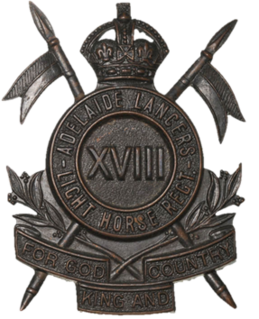
The 18th Light Horse Regiment was a Citizens Military Force unit of the Australian Light Horse, formed during the post-World War I reorganisation of the Australian Army. The regiment traces its origins back to the militia cavalry regiments raised in the colony of South Australia, such as the Adelaide Cavalry Squadron, the Adelaide Mounted Rifles and the South Australian Mounted Rifles. This is a different unit to the pre-World War I, 18th Australian Light Horse.
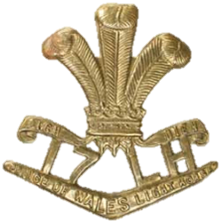
The 17th Light Horse Regiment was a Citizens Military Force (CMF) unit of the Australian Light Horse, formed during the 1912 reorganisation of the Australian Army. The regiment traces its origins back to the militia cavalry regiments raised in the colony of Victoria, such as the Royal Volunteer Cavalry Regiment, the Prince of Wales's Light Horse Hussars and the Sandhurst Cavalry Troop.


















